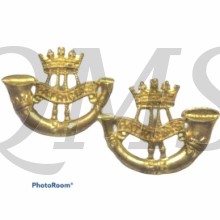Collar badges Princess Patricia's Canadian Light Infantry
World War II began in Europe on September, 1st 1939, and the Canadian Parliament declared war between Canada and Germany on September 10, 1939. The same day, the Patricias were mobilized for active service.[a 6] The regiment recruited in Winnipeg and Vancouver until October.[a 6] The regiment sailed from Halifax, Nova Scotia on the December 21, 1939, arriving in Aldershot, England, as part of the 2nd Brigade of the 1st Canadian Infantry Division under the command of Lieutenant Colonel W.G. Colquhoun.[a 6] They spent New Year's Eve in Cove, west of Farnborough. On February 10, 1940, the colonel-in-chief, Princess Patricia, inspected her regiment for the first time in twenty-one years.[a 6] The regiment spent three and a half years in United Kingdom, most of which was spent in coastal defence and training in various parts of the country.
On July 10, 1943, the PPCLI, forming part of the 1st Canadian Infantry Division and the British Eighth Army, landed in Sicily during Operation Husky.[a 6] The Patricia won its first battle honours of the Second World War at Leonforte.[a 6] Later, on September 4, 1943, the regiment landed and fought in Italy, advancing North for two months. The unit was slowed down by the demolished bridges and the German rear guard.[a 6] In December 1943 the regiment fought during the Moro River Campaign; that year the soldiers spent Christmas in Ortona.
In May 1944 the PPCLI took part in the offensive against the Hitler Line, west of Monte Cassino, during the allied offensive against Rome.[a 6] At that point the regiment was a component of the newly formed 1st Canadian Corps. In August the unit took part in the offensive against the Gothic Line and in the assaults on San Fortunato and Rimini.
On March 13, 1945, the 1st Canadian Corps was transferred to Northwest Europe where it joined the 1st Canadian Army and took part in the liberation of the Netherlands. Shortly after, the regiment captured the city of Apeldoorn, and, on May 7, 1945, it was the first allied force to enter Amsterdam, under the command of Lieutenant Colonel Clark.
On June 1, 1945, a new battalion of the regiment was authorized to be part the Canadian Pacific Force in the campaign against Japan.
Its official designation was 1st Canadian Infantry Battalion, Princess Patricia's Canadian Light Infantry, 2nd Canadian Infantry. After the destruction of Hiroshima and Nagasaki by American atomic bombs and Japan's subsequent surrender on August 15, 1945, the Pacific Force was disbanded. On September 2, the new battalion was renamed 2nd Battalion, Princess Patricia's Canadian Light Infantry, Canadian Infantry Corps and became a component of the interim force, waiting for the formation of a permanent force.
In October 1945, the regiment's serving battalion in Europe, understrength, returned to Winnipeg and was demobilized.



